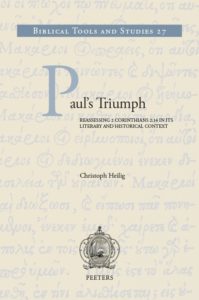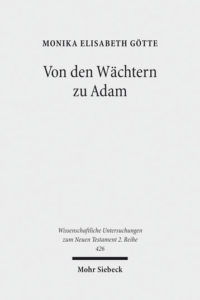Again, we would like to share with you some new reviews of recent monographs by members of our group:
Jutta Leonhardt-Balzer in JSNT 39 (p. 103) on Monika Götte‘s Von den Wächtern zu Adam: Frühjüdische Mythen über die Ursprünge des Bösen und ihre frühchristliche Rezeption:
This revised Zurich PhD thesis studies the two most important models for the explanation of the origin of evil in early Judaism and early Christianity: the Watcher myth and the Adam motif. After an introduction on myths and different forms of the explanation of evil (strict monotheism, fall of the watchers, dualistic ideas, fall of Adam, primordial fall of Satan, and evil inclination), the first main part examines the watcher myth (1En. 1–36) and its reception, both in Jewish (1En. 85–90, Jubilees, Qumran, Testaments of the Twelve Patriarchs, Ben Sira, 3Maccabees, Philo, Liber Antiquitatum Biblicarum, Josephus, 2Baruch) and Christian sources (1 Corinthians, 1 Peter, Judas, Justin Martyr, Tatian, Athenagoras, Irenaeus, Clement of Alexandria, Bardesanes of Edessa, Tertullian, Origen, Cyprian, Commodianus, ps-Clementine Homilies). The second main part studies the Adam myth (Gen. 3), which replaced the watcher myth over time, looking again at Jewish (see above, plus 4Maccabees, 2Enoch, 4Ezra, Apocalypse of Adam, Apocalypse of Moses, Life of Adam and Eve) and Christian sources (much of the above, plus Romans, 1 Timothy, Revelation, Hippolytus of Rome, Lactantius).
The thesis provides an impressively comprehensive overview of the plurality of early Jewish and early Christian concepts of the origin of evil and draws attention to the shift in its explanation from the Watcher myth with its involvement of supernatural powers towards the Adam myth and its focus on human nature, both times in an attempt to explain the origin of evil without God’s involvement. The range of material ensures that this book will be a welcome resource for the study of these two myths for quite some time to come.
The author has summarised her work on our blog here.
Gudrun Nassauer in RBL 07/2018 on Christoph Heilig’s Paul’s Triumph: Reassessing 2 Corinthians 2:14 in Its Literary and Historical Context:
The title of this recent work by Christoph Heilig is already part of the question: Does 2 Cor 2:14 demonstrate that Paul imagines himself as triumphant, or does the metaphor rather point to the end of the triumphal procession and being led to execution, which a number of scholars associate with the possible Roman background of θριαμβεύειν? In any case, the metaphor Paul uses in 2 Cor 2:14b and its implications for the reconstruction of the Pauline self-understanding have puzzled Pauline research for a long time. In his monograph Heilig tries to resolve the questions linked to the interpretation of the verse by means of a comprehensive semantic analysis, by a discussion of different options for the metaphor’s cultural background, and in a critical dialogue with earlier interpreters. […]
The present volume is a very fine piece of exegetical work that provides us with fresh and helpful insights for considering an important problem related to the appropriate understanding of Paul’s apostolic self-understanding. Heilig supports his lexical semantic analysis and his exegesis of the triumph metaphor with extensive evidence drawn from both the study of Greco-Roman sources and the dialogue with earlier research on 2 Cor 2:14. His methodology seems very well thought out and is inspiring. The same is true of his consistently careful linguistic analyses and exegetical interpretations. In sum, this stimulating read can be highly recommended.
Learn more about the book here!


Keine Kommentare vorhanden
Es gibt noch keine Kommentare.
Kommentar schreiben